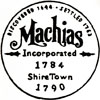Machias, Maine
| Machias, Maine | ||
|---|---|---|
| Town | ||
|
||
| Location within the state of Maine | ||
| Coordinates: 44°41′N 67°28′W / 44.683°N 67.467°WCoordinates: 44°41′N 67°28′W / 44.683°N 67.467°W | ||
| Country | United States | |
| State | Maine | |
| County | Washington | |
| Incorporated | June 23, 1784 | |
| Government | ||
| • Type | Town meeting | |
| Area | ||
| • Total | 14.80 sq mi (38.33 km2) | |
| • Land | 13.87 sq mi (35.92 km2) | |
| • Water | 0.93 sq mi (2.41 km2) 6.28% | |
| Elevation | 82 ft (25 m) | |
| Population (2010) | ||
| • Total | 2,221 | |
| • Estimate (2012) | 2,184 | |
| • Density | 160.1/sq mi (61.8/km2) | |
| Time zone | Eastern (EST) (UTC-5) | |
| • Summer (DST) | EDT (UTC-4) | |
| ZIP code | 04654 | |
| Area code(s) | 207 Exchange: 255 | |
| FIPS code | 23-41960 | |
| GNIS feature ID | 0582573 | |
| Website | www |
|
Machias /məˈtʃaɪ.əs/ is a town in and the county seat of Washington County in downeast Maine, United States. As of the 2010 census, the town population was 2,221. It is home to the University of Maine at Machias and Machias Valley Airport, a small public airport owned by the town. The word Machias roughly translates in Passamaquoddy as "bad little falls", a reference to the Machias River. Machias is best known as the site of the second naval battle in the American Revolution.
The English first became acquainted with the area in 1633, when Richard Vines established a trading post for the Plymouth Company at what is now Machiasport.
A fierce contest was at this time going on between France and England. Charles de la Tour, the French commander of Acadia, made a descent upon it from his seat at Port Royal, Nova Scotia, killing two of its six defenders, and carrying the others away with their merchandise. No persistent attempt was again made to hold this point by the English or French for upwards of 120 years.
...
Wikipedia


